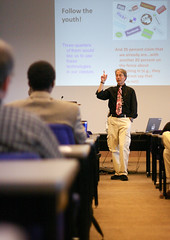Over the past few days I have been thinking more intensely about the meaning and nature of academic transformation.
In the wake of the TLT Symposium at Penn State last weekend, I traveled to Orlando to participate in the National Center for Academic Transformation’s Redesign Alliance conference.
I have been struck by a contrast that disappoints me from a national perspective even as it encourages me at local level.
The TLT Symposium was a dynamic, vibrant and innovative event that used technology and face to face communication to engage participants – faculty, administrators and students – by challenging us to think critically and imaginatively about teaching and learning in a digital age. NCAT has been a rather traditional conference in which faculty and administrators rehearsed some of the ways course and program redesign have been able to “increase efficiencies” and “improve learning outcomes.”
The contrast between the two gatherings was striking from the moment I began listening to Kay McClenney, Director of the Center for Community College Student Engagement, give the opening keynote address at NCAT. Although she had a number of important reminders, most notably that engagement matters and that we “need to do education differently with technology,” one point she emphasized struck me as unfortunate: “Students don’t do optional.”
This was infelicitous not only because it has become an oft repeated mantra at the conference, but also because it amplifies and reinforces what seems to be a common underlying assumption that students must be coerced to perform academically. This became palpably clear when McClenney reported the results of a survey of community college student attitudes in which 90% of students themselves say they have the motivation to succeed and 84% say they are academically prepared. The audience of administrators and faculty responded to these data with derisive laughter.
Allan Gyorke has blogged a bit about the session and he makes the point there that some students DO optional, reinforcing it with concrete examples from student engagement at Penn State. I, however, would like to emphasize here that when faculty respect and empower their students, new and often surprising possibilities of engagement open. We close ourselves to those possibilities when we enter into relation with our students skeptical of their motivation and disdainful of their degree of preparation.
It is no excuse here, as I heard in one session, that we are inheriting twelve years of bad educational habituation. This was said in a session in which faculty were at a loss as to what else they might do to engage students in psychology beyond an allegedly innovative redesign in which frequent quizzing with random questions “at least gave the students the structure necessary to retain the information” they needed to proceed. Upon hearing this response, I was completely deflated.
Contrast this with the elevated sense of optimism I felt hearing the ways some my colleagues at Penn State and others, like our keynote speaker, Michael Wesch of Kansas State, are using technology to empower students to take ownership of their own education. The power of the models these colleagues are developing lie in the way they use technology to relinquish some traditional sense of faculty control in order to regain authority, as Wesch so nicely put it, through student discussion. To do this well requires recognizing that students have something to say and that they want to make their educational experience relevant.
I have seen the educational power of relinquishing some control to empower student engagement in my own philosophy courses. I hope that all our efforts to redesign courses and programs are guided by the overarching goal of transforming ourselves and our students in ways that make them and us able to live more meaningful lives. That endeavor must be, at its core, cooperative and practiced.
Despite my frustration, I will end on this positive note and leave you with links to some of the strategies I learned about that might help us redesign education along the lines I suggest above: Learning Emporium model, Buffet model, Calibrated Peer Review.



Hey Chris. I may have a different perspective on conference attendance than you. I go in expecting them to be like going to a garage sale – you go to browse through other people’s stuff and look for a few treasures that you might want to take home with you.
The design elements that you list at the end of this post were some of the treasures that I found at the conference. I’d like to add the “undergraduate learning assistants” discussions to the list. Sam Richards and Andrew have used undergraduate students to run discussion sessions that go along with large course presentations. It was great to see many other institutions being successful with this approach.
I’d also like to add the “linked workshop” model, where a course like college algebra could be taken by someone who is lacking the prerequisite skills by enrolling them in a section of a course that provides just-in-time tutorials linked with the main section.